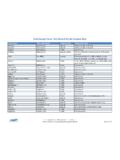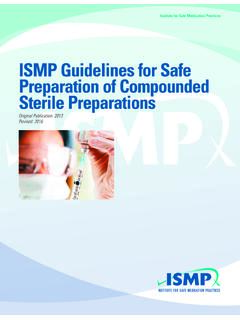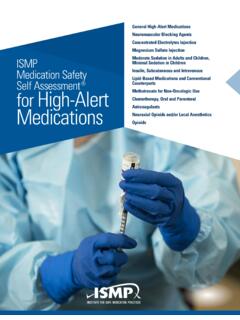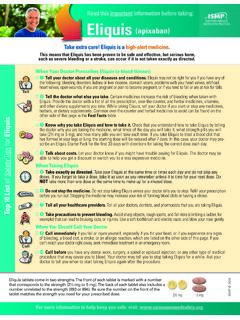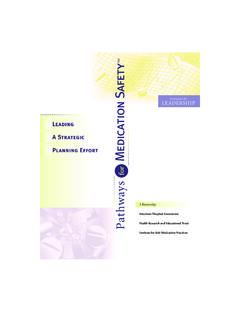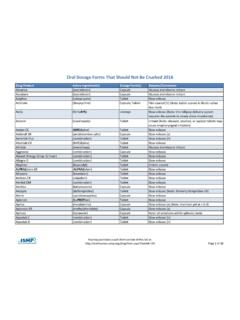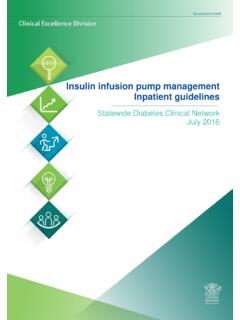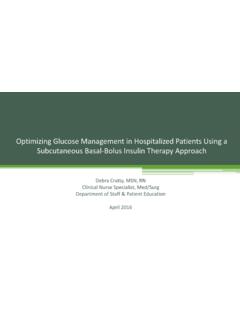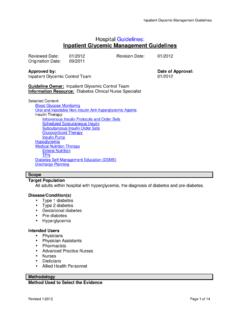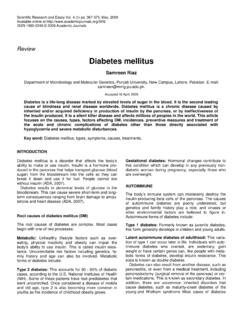Transcription of 2017 ISMP Guidelines for Optimizing Safe Subcutaneous ...
1 2017 ISMP Guidelines for Optimizing Safe Subcutaneous Insulin Use in AdultsTable of ContentsIntroduction 3 Risk Associated with Subcutaneous Insulin Use in Adults 5 Risk Associated with Prescribing Subcutaneous Insulin 6 Risk Associated with Dispensing Subcutaneous Insulin 6 Risk Associated with the Preparation and Administration of Subcutaneous Insulin 7 Risk Associated with the Use of Insulin Pens and Vials 9 Risk Associated with Monitoring Patients on Subcutaneous Insulin 11 Risk Associated with Educating Patients on Subcutaneous Insulin 11 Developing Consensus Guidelines for Safe Subcutaneous Insulin Use 12 Safe Practice Guidelines for Subcutaneous Insulin Use in Adults 131. Prescribing of Subcutaneous Insulin 132. Pharmacy Management and Distribution of Subcutaneous Insulin 163.
2 Administration and Monitoring of Subcutaneous Insulin 184. Safe Transitions of Care for Patients Receiving Subcutaneous Insulin 20 Future Inquiry 22 Conclusion 22 References 23 Definitions 28 Summit Participants 29 Appendix A Safe Practice Guidelines for Subcutaneous Insulin Use in Adults 31 Disclosure 34 About ISMP 34 Cover photo taken by ISMP fellow Ghadeer Banasser. 2017 ISMP Guidelines for Optimizing Safe Subcutaneous Insulin Use in mellitus is an increasingly common diagnosis encountered and managed in both the inpatient and outpatient settings.
3 One of the primary goals in diabetes treatment is to reduce episodes of hyperglycemia while minimizing the risk of hypoglycemic episodes. While Subcutaneous insulin therapy is the cornerstone of hyperglycemic treatment, insulin is a high-alert medication that can be associated with significant patient harm when used in as a High-Alert MedicationMedications that are associated with the highest risk of injury when used in error are known as high-alert medications. Insulin has long been identified as belonging to this group of According to a 2014 survey of pharmacists and nurses conducted by the Institute for Safe Medication Practices (ISMP), intravenous (IV) insulin ranked first, and Subcutaneous insulin ranked ninth among nearly 40 drugs and drug classes identified as high-alert medications that concerned Yet, of all the high-alert medications, Subcutaneous insulin came in last place when pharmacists and nurses were asked to rank how confident they were regarding the effectiveness of hospital-wide precautions to prevent serious errors.
4 The survey findings suggest a consensus among pharmacists and nurses that hospitalized patients are vulnerable to errors with Subcutaneous insulin, and that more must be done to prevent patient harm with this high-alert medication. Incidence of Insulin Errors For many years, insulin has been shown to be associated with more medication errors than any other type or class of drugs. As early as 1998, insulin was associated with 11% of all harmful medication errors in More recent studies add evidence to the high frequency of insulin involvement in harmful medication errors. In 2004, a state reporting program established that 25% of all reported medication errors involved high-alert medications, and 16% involved insulin Data published in 2008 showed that insulin was the leading drug involved in harmful medication errors, representing 16% of all medication error events with reported A 2010 study found that the most common medical errors in critical care patients were insulin administration Types and Causes of Insulin Errors A variety of error types have been associated with insulin therapy, including administration of the wrong insulin product, improper dosing (under-dosing and overdosing), dose omissions, incorrect use of insulin delivery devices, wrong route (intramuscular versus Subcutaneous ), and improper patient monitoring.
5 Many errors result in serious hypoglycemia or hyperglycemia. Hypoglycemia is often caused by a failure to adjust insulin therapy in response to a reduction in nutritional intake, or an excessive insulin dose stemming from a prescribing or dose measurement Other factors that contribute to serious hypoglycemia include inappropriate timing of insulin doses with food intake, creatinine clearance, body weight, changes in medications that affect blood glucose levels, poor communication during patient transfer to different care teams, and poor coordination of blood glucose testing with insulin administration at meal 2017 ISMP Guidelines for Optimizing Safe Subcutaneous Insulin Use in commonly results from reliance on only sliding scale insulin to control blood glucose, a failure to optimize treatment by increasing the dose of insulin, dosing errors, and dose ,7 Stress from an illness, injury, or surgery; lack of exercise; not following a diabetic diet plan.
6 Not injecting insulin properly; using expired insulin; using certain medications that affect blood glucose levels; or not taking insulin as prescribed due to fear of weight gain are additional factors that contribute to Other system-based barriers to achieving glycemic control include communication failures during TRANSITIONS OF CARE, glucose testing that is not coordinated well with meals and drug therapy, knowledge deficits surrounding treatment, lack of automated clinical alert systems to track and trend glycemic control, and the amount of incremental nursing time needed for complex insulin ,12 Suboptimal prescribing of insulin, which also leads to hyperglycemia, may be due to a lack of knowledge and expertise on the part of the prescriber or fear of causing 2017 ISMP Guidelines for Optimizing Safe Subcutaneous Insulin Use in Associated with Subcutaneous Insulin Use in AdultsAlthough insulin can be lifesaving, it can also cause life-threatening injuries or death when used inappropriately as both overdoses and under-doses of insulin can cause In an inpatient setting, manifestations of poor glycemic control including severe hypoglycemia and hyperglycemia are deemed hospital-acquired conditions by the Centers for Medicare and Medicaid Services (CMS).
7 CMS notes that poor glycemic control can be reasonably prevented with implementation of evidence-based Guidelines ; thus, the Agency denies payment for diabetic ketoacidosis , hypoglycemic coma, and other serious conditions related to poor glycemic is associated with significant morbidity and mortality, particularly from cardiovascular, cerebrovascular, and patient fall ,14,15 Insulin was implicated in 33% of medical errors that caused death within 48 hours of the A review in 2011 of more than 16,000 patient safety incidents involving insulin showed that 24% resulted in patient A 2011 study of emergency hospitalizations for adverse drug events in older Americans reported that insulin was one of four medications implicated in 67% of all emergency admissions due to adverse drug A more recent 2014 study looked at national estimates of insulin-related hypoglycemia and errors leading to emergency department (ED) visits and This study found there were nearly 100,000 visits for insulin-related hypoglycemia annually, with one-third resulting in hospitalization.
8 Severe neurological outcomes were documented in an estimated 61% of ED visits for insulin-related hypoglycemia, and blood glucose levels of 50 mg/dL or less were recorded in more than half of the cases. This study also found that patients 80 years old or older were twice as likely to visit an ED for evaluation of insulin-related hypoglycemia than those 45-79 years old, and patients in the oldest group were almost five times more likely to be hospitalized than those 45-64 years of age. Inpatient episodes of hypoglycemia have resulted in increased mortality (particularly in critically ill patients), longer length of stay (by 3 days) and subsequent higher inpatient charges ( ), and a greater risk of discharge to a skilled nursing facility rather than is also common in Managing inpatient hyperglycemia can be difficult if the patient experiences fluctuations in their nutritional status, or if they are prescribed medications or fluids that cause hyperglycemia ( , steroids or dextrose).
9 11,12 ketoacidosis and hyperosmolar hyperglycemia are the two most serious metabolic complications in patients with The mortality rate in patients with diabetic ketoacidosis is about 5%, and for hyperosmolar hyperglycemic state is 15%. The prognosis is worse for the very young and the elderly, and in the presence of comorbid conditions such as Targeted Priority Areas of RiskWhile many healthcare organizations have focused improvement activities on the safe prescribing, dispensing, preparation, and administration of Subcutaneous insulin along with proper patient monitoring and education, insulin errors and unanticipated harmful consequences persist. ISMP has published numerous cases involving deadly and harmful insulin-related errors and has served as a safe practice authority on the use of this medication. During the past several years, ISMP, along with other healthcare organizations, has identified several specific categories of risk associated with Subcutaneous insulin use that have been overlooked and inadequately addressed in healthcare organizations.
10 2017 ISMP Guidelines for Optimizing Safe Subcutaneous Insulin Use in ASSOCIATED WITH PRESCRIBING Subcutaneous INSULINE rrors and poor outcomes with sliding scale insulin dosing Studies demonstrate, and experts agree, that there is little evidence for using only sliding scale insulin to control blood ,24,25 A number of published articles have also focused on the problems associated with sliding scale insulin, primarily related to the heightened risk of errors with this dosing method and the roller coaster effect on blood glucose levels that often ,24,26,27 Authors of a literature review concluded that fluctuating glucose levels are more harmful physiologically than levels that are continuously Yet, sliding scale insulin using multiple complex or non-standard insulin algorithms remains a treatment strategy at some US hospitals, leading to confusion, wrong dose errors, and untoward patient ,27,29 According to the 2017 American diabetes Association (ADA) Guidelines , non-critically ill, diabetic patients who are hospitalized should be managed with scheduled Subcutaneous insulin doses that include BASAL, NUTRITIONAL, and CORRECTIONAL components as the preferred method for achieving and maintaining glucose or absent insulin standard order setsAuthoritative Guidelines and consensus statements from the Endocrine Society, ADA, American Association of Endocrinologists (AACE), and American College of Endocrinology (ACE) recommend a defined format for prescribing all insulin orders ( , preprinted order forms, computerized order sets in electronic prescribing systems).
